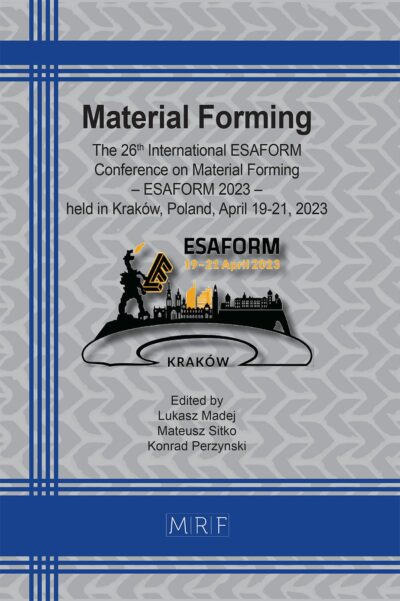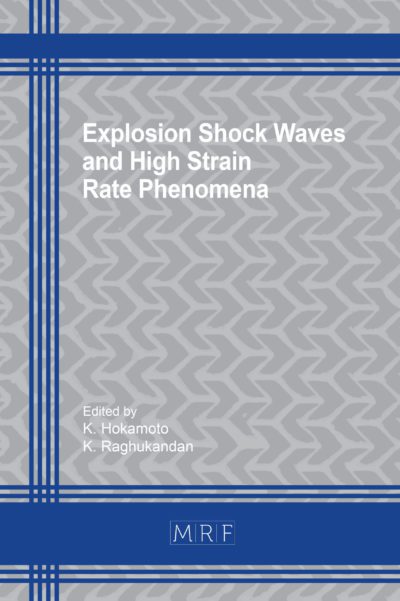–
Optimization of the temperature profile of PET preform via a 3D modelling of the Infrared Heating and ventilation
LUO Yun-Mei, CHEVALIER Luc, NGUYEN Thanh Tung
download PDFAbstract. Thermal effect has important influence during the stretch blow moulding (SBM) process of PET bottle. Setting the heating condition in an industrial context is a complex task. A 3D simplified modelling of the heating stage during this process is proposed. In this numerical approach, the radiation source is simulated by using a model for intensity of the incident radiation and the Beer Lambert’s law. On the other hand, the ventilation effect under industrial condition is taken into account by a modelling of the forced convection around a cylinder. The IR flux and ventilation effects are implemented as thermal boundary conditions in COMSOL for a 3D computation of the thermal problem for the preform only. Based on this simplified approach to achieve quickly the numerical simulation of the preform heating, an optimization procedure is proposed to adjust the settings of the infrared lamps by comparing our simulation results to the target temperature profile. This optimization tool provides quickly a first set of parameters to help industrial to obtain the desired temperature profile.
Keywords
Infrared Heating, Numerical Simulation, Ventilation Effect, Optimization
Published online 4/24/2024, 11 pages
Copyright © 2024 by the author(s)
Published under license by Materials Research Forum LLC., Millersville PA, USA
Citation: LUO Yun-Mei, CHEVALIER Luc, NGUYEN Thanh Tung, Optimization of the temperature profile of PET preform via a 3D modelling of the Infrared Heating and ventilation, Materials Research Proceedings, Vol. 41, pp 2584-2594, 2024
DOI: https://doi.org/10.21741/9781644903131-284
The article was published as article 284 of the book Material Forming
![]() Content from this work may be used under the terms of the Creative Commons Attribution 3.0 license. Any further distribution of this work must maintain attribution to the author(s) and the title of the work, journal citation and DOI.
Content from this work may be used under the terms of the Creative Commons Attribution 3.0 license. Any further distribution of this work must maintain attribution to the author(s) and the title of the work, journal citation and DOI.
References
[1] Luo Y.-M., Chevalier L. On induced properties and self heating during free blowing of PET preform. (2019) International Polymer Processing, 34 (3), p. 330 – 338. https://doi.org/10.3139/217.3759
[2] G.H. Menary, C.G. Armstrong, R.J. Crawford, J.P. McEvoy. (2000). Modelling of poly(ethylene terephthalate) in injection stretch–blow moulding, Plastics, Rubber and Composites, 29:7, 360-370. https://doi.org/10.1179/146580100101541166
[3] N. Billon, M. Picard, E. Gorlier. (2014). Stretch blow moulding of PET; structure development and constitutive model. Int J Mater Form 7, 369–378. https://doi.org/10.1007/s12289-013-1131-1
[4] F.M. Schmidt, J.F. Agassant, M. Bellet. (1998). Experimental study and numerical simulation of the injection stretch/blow molding process. Polym Eng Sci, 38: 1399-1412. https://doi.org/10.1002/pen.10310
[5] Luo Y.-M., Chevalier L., Monteiro E., Utheza F. Numerical simulation of self heating during stretch blow moulding of PET: viscohyperelastic modelling versus experimental results (2021) International Journal of Material Forming, 14 (4), p. 703 – 714, 10.1007/s12289-020-01565-w
[6] Timur, M. The Effect of Temperature, Pressure and Stretch Bar on Product Quality in Production of 0.5 L Pet Bottle. Int. J. Precis. Eng. Manuf. (2023). https://doi.org/10.1007/s12541-023-00899-0
[7] H. Groot, C.G. Giannopapa, R.M.M. Mattheij. A Computer Simulation Model for the Stretch Blow Moulding Process of Polymer Containers. Proceedings of the ASME 2010 Pressure Vessels and Piping Division/K-PVP Conference. ASME 2010 Pressure Vessels and Piping Conference: Volume 5. Bellevue, Washington, USA. July 18–22, 2010. pp. 567-576. ASME. https://doi.org/10.1115/PVP2010-25710
[8] Y.M. Luo, L. Chevalier, F. Utheza. X. Nicolas. Simplified Modelling of the Infrared Heating Involving the Air Convection Effect before the Injection Stretch Blowing Moulding of PET Preform. Material Forming ESAFORM 2014, May 2014, Espoo, Finland. Jari Larkiola, 611 – 612, pp.844-851, 2014. DOI: 10.4028/www.scientific.net/KEM.611-612.844
[9] Venkateswaran G., Cameron M.R., Jabarin S.A. Effects of temperature profiles through preform thickness on the properties of reheat-blown PET containers. Adv. Polym. Technol., 17 (3) (1998), pp. 237-249, 10.1002/(SICI)1098-2329(199823)17:3
[10] Y. M. Luo, L. Chevalier, F. Utheza, X. Nicolas. Simplified modeling of the convection and radiation heat transfers during the infrared heating of PET sheets and preforms Nomenclature. International Polymer Processing, 2015, 30 (5), pp.554-565. https://doi.org/10.3139/217.3092
[11] Z.q. Yang, W. Naeem, G. Menary, J. Deng, K. Li. (2014). Advanced Modelling and Optimization of Infared Oven in Injection Stretch Blow-moulding for Energy Saving, IFAC Proceedings Volumes, Volume 47, Issue 3, Pages 766-771, ISSN 1474-6670, https://doi.org/10.3182/20140824-6-ZA-1003.01191
[12] M. Bordival, F. M. Schmidt, Y. Le Maoult and V. Velay. (2009). Optimisation of preform temperature distribution for the stretch-blow moulding of PET bottles: Infrared heating and blowing modelling, Polymer Engineering and Science, vol. 49, no. 4, pp. 783-793. DOI:10.1007/s12289-008-0232-8
[13] Z.q. Yang, W. Naeem, G. Menary, J. Deng, K. Li. (2014). Advanced Modelling and Optimization of Infared Oven in Injection Stretch Blow-moulding for Energy Saving, IFAC Proceedings Volumes, Volume 47, Issue 3, Pages 766-771, ISSN 1474-6670, https://doi.org/10.3182/20140824-6-ZA-1003.01191
[14] Nguyen, T.T., Luo, YM., Chevalier, L. et al. Numerical Simulation of Infrared Heating and Ventilation before Stretch Blow Molding of PET Bottles. Int J Mater Form 16, 37 (2023). https://doi.org/10.1007/s12289-023-01763-2
[15] Nixon J, Menary G. H., Yan S. (2017). Assessing the Stretch-blow Moulding FE Simulation of PET over a Large Process Window. AIP Conference Proceedings 1896, 060008; https://doi.org/10.1063/1.5008071














